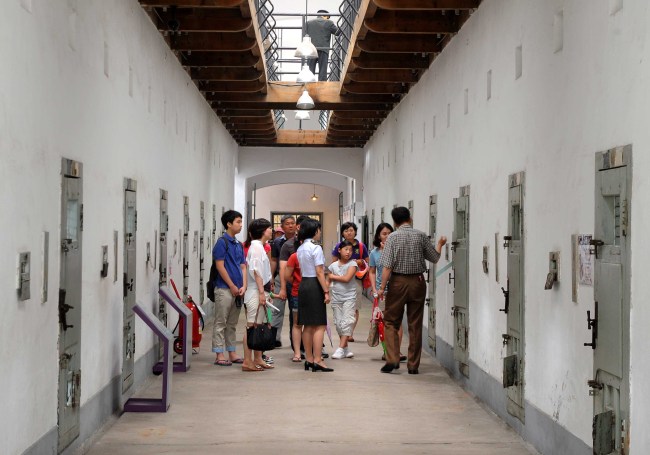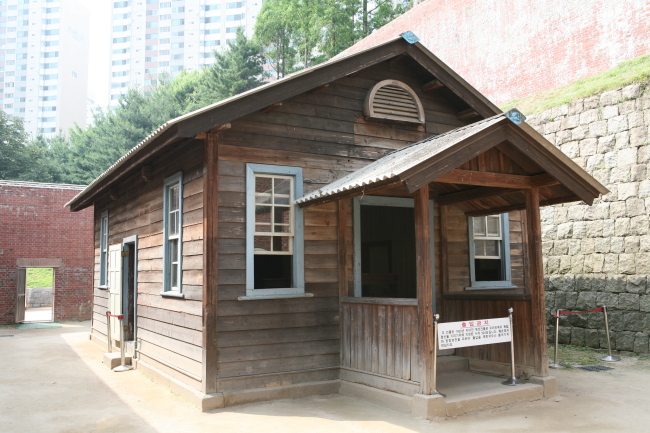Former prison lives with vestiges of Korea’s patriotic past
The prisons in post-reform Japan and its colonial territories served as cauldrons for molding loyal imperial subjects, and decimating the revolutionary enemies of the empire.
Published : 2018-08-02 14:44:21
In the 1975 book “Discipline and Punish: The Birth of the Prison” by Michel Foucault, the late philosopher builds on Jeremy Bentham’s concept of the panopticon -- a type of institutional building for social control, where prisoners are surveilled by a watchman at the center -- as a disciplinary tool of the modern state machinery.
In the course of its ruthless imperial expansion and oppression, Japan constructed a long chain of panopticon-shaped penitentiaries across the Korean Peninsula from the early 20th century.
The prisons in post-reform Japan and its colonial territories served as cauldrons for molding loyal imperial subjects, and decimating the revolutionary enemies of the empire.
With Liberation Day on Aug. 15 just around the corner, those keen on taking in a slice of the nation’s arduous modern history can visit Seodaemun Prison History Hall in northern Seoul. A former penitentiary opened in 1908 by the Japanese colonialists, the venue is now a precious bastion of learning.
In the course of its ruthless imperial expansion and oppression, Japan constructed a long chain of panopticon-shaped penitentiaries across the Korean Peninsula from the early 20th century.
The prisons in post-reform Japan and its colonial territories served as cauldrons for molding loyal imperial subjects, and decimating the revolutionary enemies of the empire.
With Liberation Day on Aug. 15 just around the corner, those keen on taking in a slice of the nation’s arduous modern history can visit Seodaemun Prison History Hall in northern Seoul. A former penitentiary opened in 1908 by the Japanese colonialists, the venue is now a precious bastion of learning.


Originally named Gyeongseong Prison, or Keijo Prison in Japanese, the jail was built for the purpose of suppressing Korean aspirations for independence and freedom. It was renamed Seodaemun Prison in 1923, and Seoul Prison after 1945.
It operated for 80 years, through 1987. During those years, thousands of freedom fighters against the Japanese and democracy activists resisting postwar authoritarian regimes were incarcerated, tortured and killed. It has stood the test of time as a living symbol of the democratization movement that erupted in 1987.
The area was refashioned as a historic site in 1988, and reopened as Seodaemun Prison History Hall in 1998.
“It’s apparent that everything that the Japanese did to the Koreans here was to break them down psychologically and physically,” Alexis Meendering, an American tourist from Sioux City, Iowa, told this reporter at the museum Tuesday.
“It seems they were very pro at doing that, very thought-out and calculated. It’s very sad that a human being can be that good at doing such terrible, evil things to others.”


The museum houses some 10 edifices and other facilities out of the original 15 buildings, including former prison buildings, factories, walls, an execution site, cookhouse, leper’s house, exercise facility and watchtower. They show in livid hues the brutal living conditions of the inmates and their day-to-day struggles in brick-and-mortar confinements.
The History Hall in the center showcases those interned during the Japanese colonial period. It has exhibition chambers in the basement that display torture techniques and equipment used by the Japanese wardens and police.
Torture techniques included peeling off the skin, rupturing internal organs, breaking and cutting fingers, driving a stake into a woman’s genitals to render her barren, as well as putting a person inside a wooden box with protruding nails and violently shaking it.
Other forms of torture were waterboarding, putting sharp skewers underneath fingernails, interrogation without sleep and locking up a prisoner in a vertical coffin for days and nights without water or food. Many perished while being tortured, or from festering wounds after their release.
Those “fortunate” to be freed from the misery were hanged at an execution site at the south corner of the prison. There is still a poplar tree standing just outside the building. It has been named the “wailing poplar,” because those taken to their final station were said to have grabbed the tree, and wailed, resenting not having seen a liberated nation.

Even under the sweltering daytime heat, there were many young students and their parents as well as foreign visitors Tuesday. A guide leading Japanese university students declined a request for an interview, saying in Korean, “We are sorry. We fear being attacked by ultra-right nationalists in Japan for giving an interview in places like this.”
“I thought Seodaemun Prison would be the most impactful place to show visitors, because there aren’t that many places in Korea that show the dark side of the Korean history so vividly,” said Nathan Meendering, who has been living in Korea for four years, standing next to his sister from the United States.
“Touring here gave me a lot of chills, especially learning about Korea’s dark history with Japan. I felt like something should be done about what happened here.”
As a foreign resident, Nathan noted, he was familiar with the comfort women issue and Dokdo Islets territorial dispute between Korea and Japan. Although “Koreans and Japanese don’t fight on the streets over these issues,” he said, “I think there’s still some bad blood between them. I think there are still a lot of things that Japan should answer for.”

The Japanese colonialists built 16 prisons across the peninsula in 1908. The number increased to 30 by the 1930s, with major cities home to several compounds.
Seodaemun Prison’s initial capacity was 500 inmates, but as the number of patriots captured during the March 1, 1919, Independence Movement swelled, it came to hold 3,000 people, making it the country’s largest penitentiary.
The Central Prison Building and its extended, corridored wards -- together forming a panopticon -- have cells showing the detailed biographies, photographs and words of independence fighters who were jailed there. With scarred walls, tiny windows and a thick steel door, each room is a ghastly reminder of the sacrifices and martyrdoms shouldered by Korea’s forgotten patriots.
The independence fighters were classified as “special criminals” and locked up in solitary cells -- without electricity, toilets or sunlight -- used for conducting torture.
Kim Koo -- a national independence hero, last premier of the republican provisional government and reunification activist -- was imprisoned in one of the cells in 1911, where he wrote his famous prison diary. Among those jailed after the March 1st Movement was the venerated female freedom fighter Ryu Gwan-soon, who died on Sept. 28, 1920 from torture and beatings at the hands of Japanese prison officers.


Between 40 and 50 people were cramped into a cell measuring 13 square meters, with barely enough space for them to sleep side by side. It was highly unsanitary and many died from maladies, frostbite and various other ailments.
Japanese prison guards with guns and swords did not hesitate to use violence in dealing with the inmates, often resorting to severe beatings. The whole system was controlled by some 350 Japanese and Korean staff, including 260 guards, 30 chief guards, a governor and deputy governor.
The inmates spent most of their time in their cells and 12 factories within the prison compound. They toiled from 10 to 14 hours at the factories, producing textiles and clothes, bricks, rough mats, agricultural and livestock products, wooden materials, paper and ironwork, among other supplies, which greased the wheels of Japan’s imperial project.
The paltry meals -- brown rice, millet and beans -- were provided thrice daily, mostly at the factories to maximize the prisoners’ working time.
Ideological education was rampant. Those who adhered to the program meekly were bestowed lenient sentences and better treatment.
“A lot of Americans don’t really know much about Korea, let alone South Korea or North Korea. Most don’t know that Korea was colonized by Japan. I didn’t know until I was told by my Korean friends and visiting here,” said Daniel Wunderink, a college student who came with the Meenderings. “I felt that history is more complicated than you might think. It’s not as simple as what you learn from the textbook.”
By Joel Lee (joel@heraldcorp.com)
http://www.koreaherald.com/common/newsprint.php?ud=20180802000520